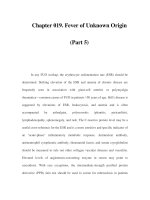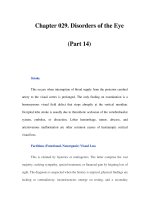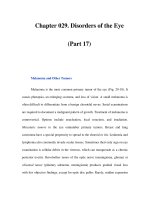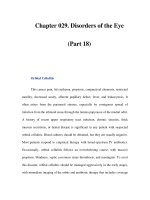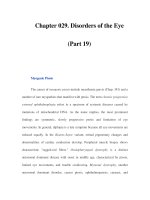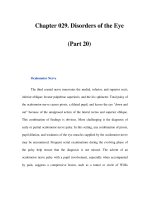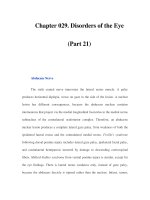Chapter 083. Cancer of the Skin (Part 5) ppsx
Bạn đang xem bản rút gọn của tài liệu. Xem và tải ngay bản đầy đủ của tài liệu tại đây (48 KB, 5 trang )
Chapter 083. Cancer of the Skin
(Part 5)
A lifetime risk of melanoma development of 6% has been estimated. The
risk is greatest before age 5 and next greatest between ages 5 and 10. Early
detection of melanoma is difficult in these lesions because of the deep dermal or
subcutaneous origin of primary melanoma and because of the large and varied
surface of the nevus. Prophylactic excision early in life can be accomplished by
staged removal with coverage by split-thickness skin grafts. Surgery cannot
remove all at-risk nevus cells as some may penetrate into the muscles or central
nervous system below the nevus. At present there are no uniform management
guidelines for giant congenital nevi. The small- to medium-sized congenital
melanocytic nevus, which affects approximately 1% of persons, usually presents as
a raised dark- to medium-brown lesion with a smooth or papillomatous surface.
The border is sharp, and lesions may be oriented along lines of skin cleavage.
Follicular hyper- and hypopigmentation may coexist in a salt-and-pepper
configuration. The lesion may have an excess of thick, coarse hairs. The risk of
melanoma developing in these lesions is not known but appears to be relatively
small. The management of small- to medium-sized congenital melanocytic nevi
remains controversial. Melanomas in small congenital melanocytic nevi appear to
occur after puberty, unlike melanomas that arise in giant congenital nevi and tend
to occur much earlier in life. Melanomas can also arise in benign dermal and
compound moles. Overall, it has been estimated that for a 20-year-old individual,
the lifetime risk of any selected mole transforming into melanoma by age 80 years
is approximately 0.03% (1 in 3,164) for men and 0.009% (1 in 10,800) for women.
Differential Diagnosis
The aim of differential diagnosis is to distinguish benign pigmented lesions
from melanoma and its precursor. If melanoma is a consideration, then biopsy is
appropriate. Some benign look-alikes may be removed in the process of trying to
detect authentic melanoma. Table 83-5 summarizes the distinguishing features of
benign lesions that may be confused with melanoma. Early detection of melanoma
may be facilitated by applying the "ABCD rules": A—asymmetry, benign lesions
are usually symmetrical; B—border irregularity, most nevi have clear-cut borders;
C—color variegation, benign lesions usually have uniform light or dark pigment;
D—diameter >6 mm (the size of a pencil eraser). Of these criteria, the weakest is
diameter >6 mm since a significant fraction of melanomas are now diagnosed with
diameters <6 mm. In addition, the above features are less helpful in the
recognition of nodular melanomas, which may be symmetrical and have uniform
colors. "Different" has been substituted for "diameter" by some. Addition of an
"E" for evolution has been proposed as other features may become more
significant if the lesion is changing.
Table 83-
5 Pigmented Lesions that Must Be Distinguished from
Cutaneous Melanoma and Its Precursors
Blue nevus Gunmetal or cerulean blue, blue-g
ray. Stable over
time. One-
half occur on dorsa of hands and feet. Lesions
are usually single, small, 3 mm to <1 cm. Must be
distinguished from nodular melanoma.
Compound
nevus
Round or oval shape, well-demarcated, smooth-
bordered. May be dome-shaped or pa
pillomatous; colors
range from flesh colored to very dark brown, with
individual nevi being relatively homogeneous in color.
Hemangioma Dome-
shaped reddish, purple, blue nodule.
Compression with a glass microscope slide may result in
blanching. Must be distinguished from nodular melanoma.
Junctional
nevus
Flat to barely raised brown lesion. Sharp border.
Fine pigmentary stippling visible, especially upon
magnification.
Lentigo
Juvenile
Solar
Flat, uniformly medium or dark brown lesion with
sharp bord
er. Solar lentigines are acquired lesions on sites
of chronic solar exposure (face
and backs of hands).
Lesions are 2 mm to
≥1 cm. Solar lentigines have
reticulate pigmentation upon magnification.
Pigmented basal
cell carcinoma
Papular border. May have central ulceration.
Usually on a sun-
exposed surface in an older patient.
Patient us
ually has dark brown eyes and dark brown or
black hair.
Pigmented
dermatofibroma
Lesion is not well demarcated visually, is firm, and
dimples downward when compressed laterally. Usually on
extremities. Usually <6 mm.
Seborrheic Rough, sharp-bo
rdered lesions that feel waxy and
"stuck on"; range in color from flesh to tan, to dark brown.
keratosis
Presence of keratin plugs in surface is helpful for
discriminating especially dark lesions from melanoma.
Subungual
hematoma
Maroon (red-
brown) coloration. As lesion grows
out from nail fold, a curving clear area is seen.
Tattoo (medical
or traumatic)
In medical tattoo, lesions are small pigmentary
dots, often blue or green, which make a regular pattern
(rectangle). Traumatic t
attoos are irregular, and
pigmentation may appear black.

